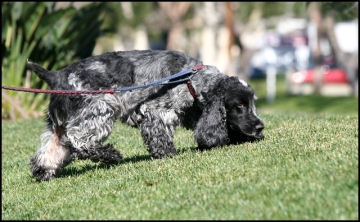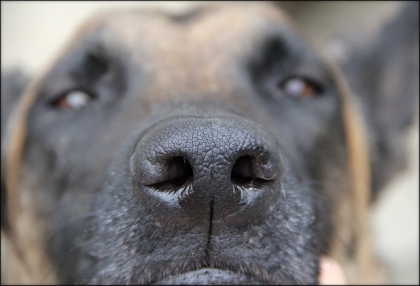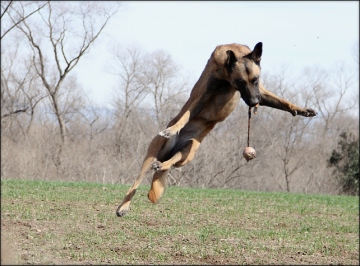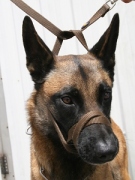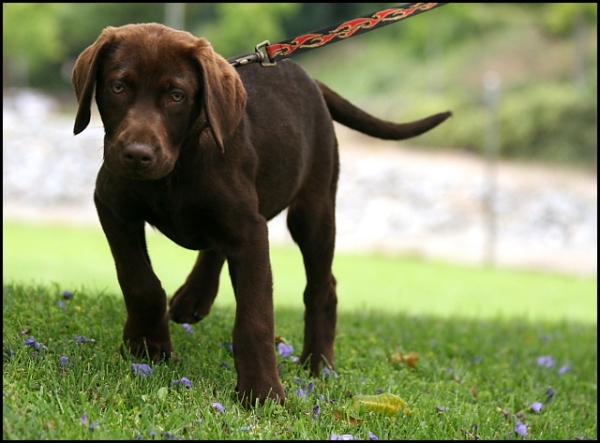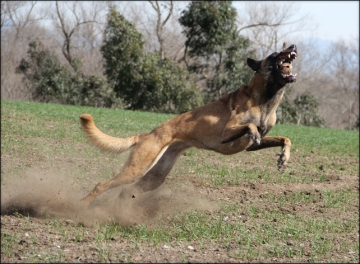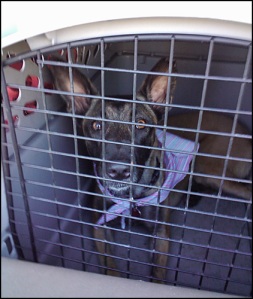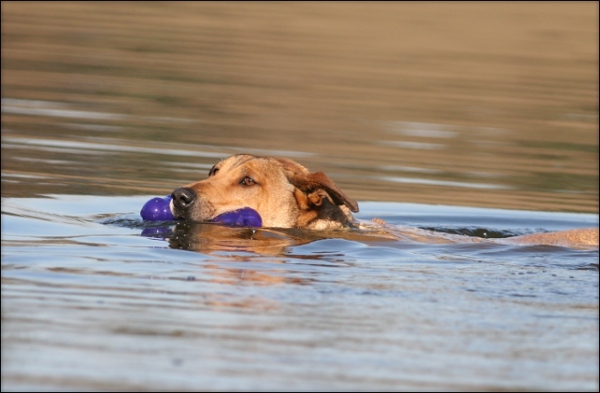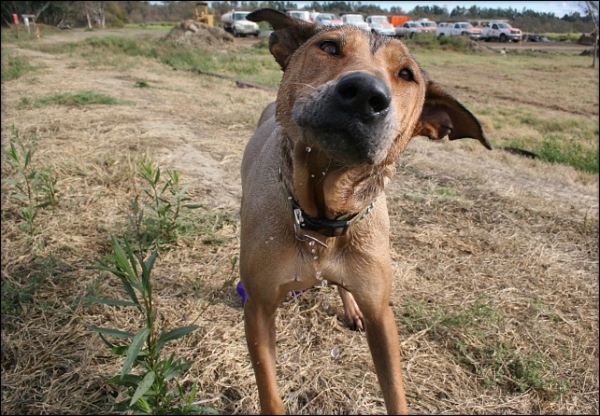Does your pooch turn into a growling mountain of fur when you try to sneak on your favorite place on the couch, where he already awaits? Is your sweet little chihuahua defending your bed – from you or your family?

Clearly, the black dog has had enough! The other dog understands and moves away.
Growling is a vocal form of communication, just like barking or whining. There are different types of growling – those who ever wrestled with a Rottweiler can tell you, that sometimes, a growl is just fun. Some dogs enjoy growling when they are playing, they may also growl, when you try to take away the piece of steak you just put on the plate for your dinner and that they are now happily chewing on. And they may growl, if they encounter a stranger, someone, they have not met before or plainly just don’t like. Even though, for many of us, these growls may sound exactly alike, they are not. In an experiment, two years ago, scientists recorded the three different growls (food growl, play growl and stranger growl) from 20 dogs and replayed these growls to dogs just about to chow down on a bone. If they were replaying the food growl, an astonishing 11 of 12 dogs withdrew from the bone within 15 seconds. Compared to the stranger growl, only 2 of the 12 dogs left the bone and 4 of the 12 dogs left it when they heard the play growl. They also counted, how many dogs would go back to the bone within 90 seconds. 7 of the dogs from the food growl group did not approach the bone, while only one from the stranger growl resp. play growl did not go back. (‘The bone is mine’: affective and referential aspects of dog growls. Farago et al., 2010)
Understanding the correct meaning of your dog growling is essential as your reaction may either escalate into a dangerous situation or simply means, having more fun, romping around with your dog. While you may feel betrayed by your dog growling at you, there are many signs that lead up to that second to final response – your dog may stare at you, ears back, hunkering down, tail wagging stiffly. Oh, yes – the tail may still be wagging, but do not be fooled. In this form, you are about to trigger an explosion. By punishing the growling, you take away an important step from ‘telling you loudly, it’s about to happen’ to ‘happening’. If you have successfully ignored all the signs the dog has given you with his body language, the growl is the one last thing that will stop you from doing what you are about to do.

Guarding the Furniture
While some ‘experts’ will tell you not to accept your dog growling at you and that you need to win this fight by all means, I’d tell them to try and use their methods on a 120 lbs English Mastiff. Even a chihuahua can execute a fast attack on your fingers and be quite painful. What’s more important though, if you have ever been bitten by your dog, your relationship and trust have just been ruined. From that day on, you will look at your dog differently. And your dog will feel this, too. So instead of instigating a situation which will hugely complicated to resolve, not to speak risking bodily injuries, let’s concentrate on defusing it. By the time your dog shows you all the signs including the growl, it is too late to start applying any sort of dominance training methods or much else. I’m neither saying you have to accept this behavior nor to tolerate it. But for that particular instance, there is not much you can do but get yourself and your dog out of this situation. If your dog is defending his place on the bed, get him down by either going into the kitchen and open the fridge (which for my dogs is always a secret sign to stand at the kitchen entrance), call your dog’s name and have treats ready (good ones, like hot dogs…) or, worst case, use a leash, form a loop, throw it over your dogs head and lead him down – the last method is only applicable, if you know that your dog works well on the leash.Do not get too close to your dog, nor bend over him. Do not be emotional, stay neutral, even positive. Once he is off your bed or couch, work some obedience with him and reward for good behavior. Do not let him go back on the furniture!
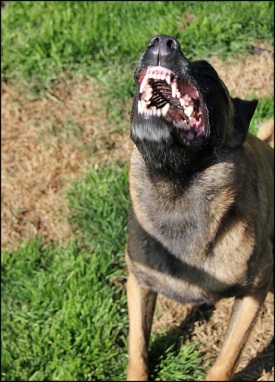
Luckily, this dog is not aggressive – I simply took a photo of her barking.
If your dog is protecting that piece of steak, let him have it, calm down and work on food aggression from now on, every day! Take away the opportunity for your dog to steal steaks (or anything else for that matter) and start training towards your dog being comfortable with you being close to his possession and even give it up for you.
Now that the situation has been defused, concentrate on what happened before your dog started to growl. If you dog growled because you approached him when he was laying comfortably on your bed, it does NOT mean, that from now on, you should not go near him, when he’s on your bed. Rather you need to work on him not getting on there in the first place – and work on your general relationship.
In all growling cases, except when playing, I strongly urge to consult with a trainer, who has experience with aggressive dogs. While a growl does not make your dog aggressive, experience with such dogs often help to understand the underlying issue and how to deal with it. Be wary of trainers who tell you to wrestle your dog to the ground and ‘show dominance’ or ‘you need to be the [alpha] [pack leader] [first rank] (pick one), try to sell you a training collar without having worked with your dog first – or have you bring the dog to them to keep for several days to weeks to train him at their training facility. While this may be a good idea for seriously aggressive dogs, a dog who growls at you to protect his food, toy or place needs to work with you under the guidance of a trainer.
If your dog is growling at you, your family and friends or strangers repeatedly, it is a serious issue and needs to be dealt with, even if you think, your 10 lbs dog is sweet, trying to protect you from your friend. Often times, it is quite easy to work with a growling dog, but if you wait until the first bite happens, things become a lot more difficult.
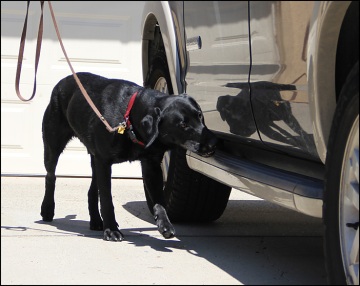 This fun and educational sport started about 6 years ago, in 2006 and exploded in popularity almost immediately. There are now classes and competitions all over the Nation as pet dog owners finally have a competitive sport, that does not require a specific breed or an athlete handler. I not only recommend it to all my clients who want to do ‘something’ with their dogs, but also to those, who’s dogs are reactive when seeing other dogs, as there are never two dogs in the same room. I have seen amazing turnarounds in dogs – and in owners! But most of all, it is an exciting team work and something, you can work on at home or even incorporate in your daily walks.
This fun and educational sport started about 6 years ago, in 2006 and exploded in popularity almost immediately. There are now classes and competitions all over the Nation as pet dog owners finally have a competitive sport, that does not require a specific breed or an athlete handler. I not only recommend it to all my clients who want to do ‘something’ with their dogs, but also to those, who’s dogs are reactive when seeing other dogs, as there are never two dogs in the same room. I have seen amazing turnarounds in dogs – and in owners! But most of all, it is an exciting team work and something, you can work on at home or even incorporate in your daily walks.
